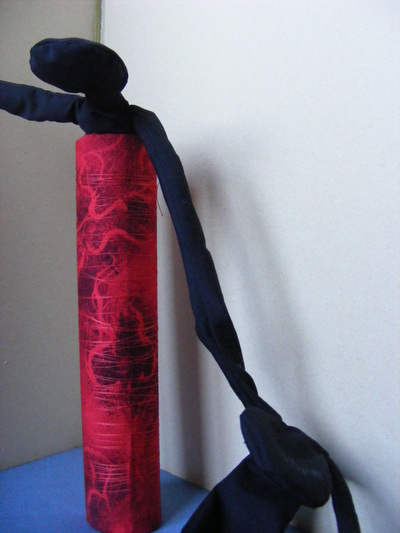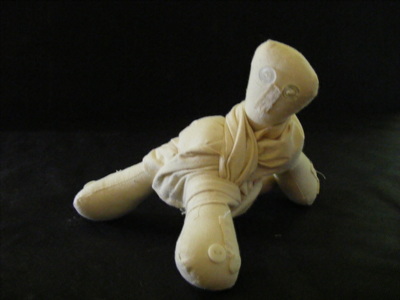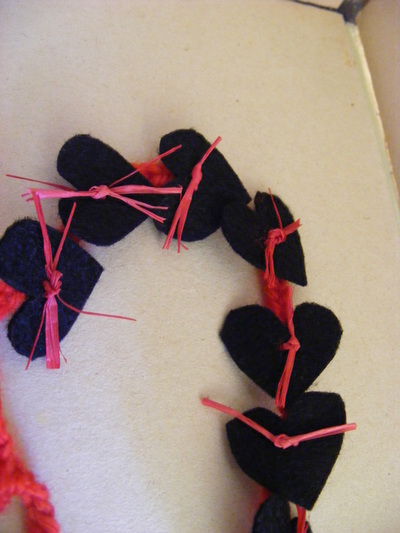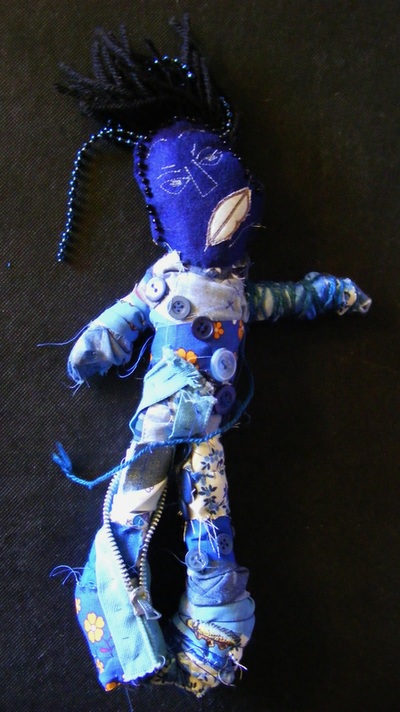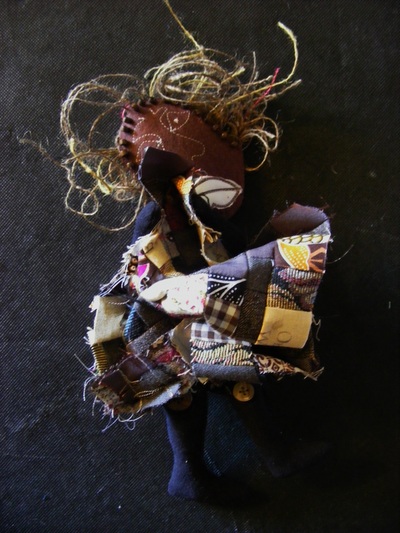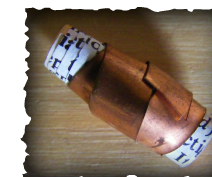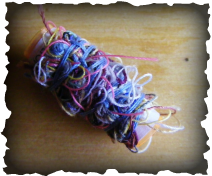HEARTFELT DOLLS:
USING TEXTILE CRAFTS IN CONTEMPORARY ART
What is contemporary art?
The J. Paul Getty Museum says,
"the term "contemporary art" refers to art made and produced by artists living today ....
When engaging with contemporary art,
viewers are challenged to set aside questions such as,
"Is a work of art good?" or
"Is the work aesthetically pleasing?"
Instead, viewers consider whether art is "challenging" or "interesting."
It continues,
"... contemporary artists pull from an infinite variety of materials, sources, and styles to create art."
Where do those using traditional crafts fit into contemporary art?
They are the artists who 'pull from an infinite variety of materials, sources, and styles.'
In their Preface to "By Hand", Shu Hung and Joseph Magliaro wrote
"... a growing number of contemporary artists are producing work with their hands,
using materials traditionally associated with craft.
These renegades replace the paintbrush with a needle and thread,
and, instead of standing in front of a canvas all day,
spend time hunched over sewing machines and embroidery hoops."
The J. Paul Getty Museum says,
"the term "contemporary art" refers to art made and produced by artists living today ....
When engaging with contemporary art,
viewers are challenged to set aside questions such as,
"Is a work of art good?" or
"Is the work aesthetically pleasing?"
Instead, viewers consider whether art is "challenging" or "interesting."
It continues,
"... contemporary artists pull from an infinite variety of materials, sources, and styles to create art."
Where do those using traditional crafts fit into contemporary art?
They are the artists who 'pull from an infinite variety of materials, sources, and styles.'
In their Preface to "By Hand", Shu Hung and Joseph Magliaro wrote
"... a growing number of contemporary artists are producing work with their hands,
using materials traditionally associated with craft.
These renegades replace the paintbrush with a needle and thread,
and, instead of standing in front of a canvas all day,
spend time hunched over sewing machines and embroidery hoops."
|
"Paradox" has replaced traditional sculptural materials with the familiar and comforting - blankets, cushions, pink yarn. In doing so it establishes a dialogue between the artist and the viewer. It confronts expectations. It raises questions and unsettles. It invites an exploration into meaning and symbolism. It challenges conventions. |
CONTEMPORARY ART REINVENTS ITSELF ...
suggests Shane Waltener,
"... by looking outside its own area for inspiration -
be it politics, science, or technology."
Breast cancer often demands removal of one or both breasts.
Science provides many options, such as silicone implants.
But many women who survive a mastectomy choose not to have reconstructive surgery.
They use prosthetics or none.
This 3-circuit labyrinth was constructed using knitted breast prosthetics.
It takes an area once dominated by science and health,
and reinvents it.
It puts the power and the choice back into the hands and hearts of those who need it.
"... by looking outside its own area for inspiration -
be it politics, science, or technology."
Breast cancer often demands removal of one or both breasts.
Science provides many options, such as silicone implants.
But many women who survive a mastectomy choose not to have reconstructive surgery.
They use prosthetics or none.
This 3-circuit labyrinth was constructed using knitted breast prosthetics.
It takes an area once dominated by science and health,
and reinvents it.
It puts the power and the choice back into the hands and hearts of those who need it.
CONTEMPORARY ART ADDRESSES ISSUES THAT UNSETTLE ...
|
... issues such as death, suffering due to war, sickness, poverty, and the misuse of power.
In my series 'The Apple', I explore misuse of power by institutional, patriarchal church. The apple - a potent symbol of creativity and immortality. To whom do these qualities belong? How has church hijacked ancient belief systems and practices? Am I aware of this history? The 'Madonna' is very naked, very pregnant. This work challenges myths and stories many hold sacrosanct. It asks viewers to consider: what do I believe? how necessary is this belief to my faith? how should we read sacred texts? am I offended? |
CONTEMPORARY ART IS ABSTRACT ...
Anna Von Mertens practice reflects my own.
She writes,
"I start with an abstract idea that I like to link with a pattern.
...The evidence of the hand evokes time and contemplation,
almost as a commitment to the ideas contained within the work."
Stitch Yourself a Boyfriend started with the abstract idea of partners.
I wanted to explore the qualities I am seeking in a partner.
I thought of a format;
designed a pattern;
scavenged for materials;
then pinned, cut, machine-sewed, stuffed and hand-sewed.
As I did these slowly, contemplatively,
I realised the qualities I sought in a partner
were the qualities I sought in friends.
Moreover, they were the qualities I sought to develop in myself:-)
She writes,
"I start with an abstract idea that I like to link with a pattern.
...The evidence of the hand evokes time and contemplation,
almost as a commitment to the ideas contained within the work."
Stitch Yourself a Boyfriend started with the abstract idea of partners.
I wanted to explore the qualities I am seeking in a partner.
I thought of a format;
designed a pattern;
scavenged for materials;
then pinned, cut, machine-sewed, stuffed and hand-sewed.
As I did these slowly, contemplatively,
I realised the qualities I sought in a partner
were the qualities I sought in friends.
Moreover, they were the qualities I sought to develop in myself:-)
CONTEMPORARY ART MAKES A SOCIAL COMMENTARY ...
Artists throughout the ages have commented on the society in which they live.
Pablo Picasso painted "Guernica".
JMW Turner painted "The Slave Ship".
Both works of art provoked and challenged.
Society was confronted by the evil of their actions.
Contemporary artists using craft also confront and provoke;
stimulate and raise awareness.
"You don't have to take it like I did" confronts the issue of domestic violence.
Who's problem is domestic violence, especially against women?
Is this kind of violence inter-generational?
How do we as individuals and communities enable the perpetrators of domestic violence?
How do we as individuals and communities enable and empower victims of abuse?
"Akuba" explores change, encourages change.
It raises issues of matriarchy and patriarchy.
It asks us to reflect on fertility and who has rights to a woman's body.
Pablo Picasso painted "Guernica".
JMW Turner painted "The Slave Ship".
Both works of art provoked and challenged.
Society was confronted by the evil of their actions.
Contemporary artists using craft also confront and provoke;
stimulate and raise awareness.
"You don't have to take it like I did" confronts the issue of domestic violence.
Who's problem is domestic violence, especially against women?
Is this kind of violence inter-generational?
How do we as individuals and communities enable the perpetrators of domestic violence?
How do we as individuals and communities enable and empower victims of abuse?
"Akuba" explores change, encourages change.
It raises issues of matriarchy and patriarchy.
It asks us to reflect on fertility and who has rights to a woman's body.
CONTEMPORARY ART IS SUCCINCT ...
|
Tucker Schwarz says,
"I hope I can say all the things I want in the most succinct and moving way with my work." Mixed Emotions is monochromatic, with the minimum of embellishments. The simplicity of materials and embellishments draws our eye and our mind to the movement and the emotion generated by this piece. |
CONTEMPORARY ART IS MULTI-LAYERED ...
... it has layers of discovery for both the artist and the audience.
In this multi-layered nature, contemporary art reflects what it is to be human.
Jeanette Winterson wrote,
"Art is about tapping into the human condition
and trying to define those turbulent but often inarticulate emotions that beset everyone.
Re-assurance isn't about the answers,
but finding a language and a structure to your feelings."
In exploring the emotions that accompanied me in the aftermath of my divorce,
I created rosaries.
I needed the comfort of a familiar prayer form,
but I also needed these beads to become a voice for that which I could not name or articulate.
This challenges many who believe that the sacred and the profane should not interact.
Are there objects and places and ideas that should never be violated?
Do artists need to consider and protect the sensibilities of others?
In this multi-layered nature, contemporary art reflects what it is to be human.
Jeanette Winterson wrote,
"Art is about tapping into the human condition
and trying to define those turbulent but often inarticulate emotions that beset everyone.
Re-assurance isn't about the answers,
but finding a language and a structure to your feelings."
In exploring the emotions that accompanied me in the aftermath of my divorce,
I created rosaries.
I needed the comfort of a familiar prayer form,
but I also needed these beads to become a voice for that which I could not name or articulate.
This challenges many who believe that the sacred and the profane should not interact.
Are there objects and places and ideas that should never be violated?
Do artists need to consider and protect the sensibilities of others?
|
When confronting unemployment, finding meaningful work is not the only issue. 'The Unemployment Blues' explores the many aspects and layers that confront and challenge the unemployed. Personal issues such as age, depression, fear, the meaning of life, belonging, injustice and anger. Wider issues such as government policy, societal attitudes, health and well-being. Global issues such as trade partnerships, ecology and child labour. |
CONTEMPORARY ART CHALLENGES AND CONFRONTS ...
The contemporary artist, according to Penny Burnfield, produces
"...work that is a physical manifestation of her need to try and make order out of a chaotic world.
Like the alchemists of old,
I see myself as the 'base material'
which I hope to transform through my work."
Every time I pick up a pen or needle or piece of fabric
I use it to transform myself and the world around me.
"...work that is a physical manifestation of her need to try and make order out of a chaotic world.
Like the alchemists of old,
I see myself as the 'base material'
which I hope to transform through my work."
Every time I pick up a pen or needle or piece of fabric
I use it to transform myself and the world around me.
|
There are many issues in our contemporary society
which defy explanation or cause us angst. Some people choose to ignore the issues or seek panacea. Others seek to cure them or hide them away in care facilities or laboratories. But I try to transform the issues, and increase awareness through the use of traditional crafts, such as knitting and sewing. Dementia is a growing issues in our modern society. How do confront the loss of faculties when we live in a society which cannot confront its own mortality? How do we hold living and dying in balance? |
CONTEMPORARY ART OFTEN WORKS IN SERIES ...
I like to work in series.
Like Hilary Bower, I
"... go over and over things,
sometimes unaware of this.I sometimes feel that to create several of something, or multiples,
reflects the way we have to keep trying or working at something,
and finally it falls into place with the last 'try' or last piece.
I also enjoy the collective nature of more than one.
That is often when they take on a life of their own, in a way, and they come to life ...
To repeat is to understand."
Working in series and with the tools of mass-reproduction
is common with contemporary artists.
They may work on one theme or subject over a given time.
Or they may manipulate a single image but give each its own unique quality.
In the series "Sticks and Stones",
I worked with a template and limited materials to explore the issue of workplace bullying.
By using the same template over and over,
I was able to focus my thoughts and creative decisions,
until I reached a place of understanding and completion.
Like Hilary Bower, I
"... go over and over things,
sometimes unaware of this.I sometimes feel that to create several of something, or multiples,
reflects the way we have to keep trying or working at something,
and finally it falls into place with the last 'try' or last piece.
I also enjoy the collective nature of more than one.
That is often when they take on a life of their own, in a way, and they come to life ...
To repeat is to understand."
Working in series and with the tools of mass-reproduction
is common with contemporary artists.
They may work on one theme or subject over a given time.
Or they may manipulate a single image but give each its own unique quality.
In the series "Sticks and Stones",
I worked with a template and limited materials to explore the issue of workplace bullying.
By using the same template over and over,
I was able to focus my thoughts and creative decisions,
until I reached a place of understanding and completion.
CONTEMPORARY ART IS OFTEN COVERT ...
|
Contemporary artists may use traditional crafts and materials as their medium,
such as guerrilla yarn-bombing in public spaces; or they may employ traditional skills to manipulate non-traditional materials, such as knitting fibreglass insulation. Each of these techniques subvert the traditional and demand our attention. 'Free My Caged Heart' uses domestic materials, such as flannelette; traditional sewing techniques; and traditional methods of making a doll, to covertly subvert all of these. This soft sculpture is not soft and cuddly: it piques the curiosity and demands we explore the idea the artist is presenting. |
I explore my world through textile art and doll-making.
Sometimes the stories I tell through this art form are simply entertainment-
aesthetically pleasing gifts of the heart.
Other times, they are my biography, revealing the significant moments in my life.
But the dolls and textile art I am most passionate about
are the works that challenge and confront;
that explode long held beliefs;
that increase awareness about contemporary issues;
that push the boundaries of what is acceptable;
that threaten the status quo;
that transform the individual and communities;
that strips away the layers of convention and pretence;
that make sense of a chaotic world;
that encourages dialogue;
that empowers the individual by offering them control of their own decision-making;
that brings artist and audience to a place of understanding.
These are the contemporary works of art,
utilising traditional and non-traditional textile crafts.
Sometimes the stories I tell through this art form are simply entertainment-
aesthetically pleasing gifts of the heart.
Other times, they are my biography, revealing the significant moments in my life.
But the dolls and textile art I am most passionate about
are the works that challenge and confront;
that explode long held beliefs;
that increase awareness about contemporary issues;
that push the boundaries of what is acceptable;
that threaten the status quo;
that transform the individual and communities;
that strips away the layers of convention and pretence;
that make sense of a chaotic world;
that encourages dialogue;
that empowers the individual by offering them control of their own decision-making;
that brings artist and audience to a place of understanding.
These are the contemporary works of art,
utilising traditional and non-traditional textile crafts.
REFERENCES:
Shu Hung and Joseph Magliaro, editors, By Hand: Using Craft in Contemporary Art, 2007, Princeton Architectural Press
Jac Scott, Textile Perspectives in Mixed-Media Sculpture, 2003, The Crowood Press Ltd
J.Paul Getty Museum, http://www.getty.edu/museum/
Shu Hung and Joseph Magliaro, editors, By Hand: Using Craft in Contemporary Art, 2007, Princeton Architectural Press
Jac Scott, Textile Perspectives in Mixed-Media Sculpture, 2003, The Crowood Press Ltd
J.Paul Getty Museum, http://www.getty.edu/museum/





